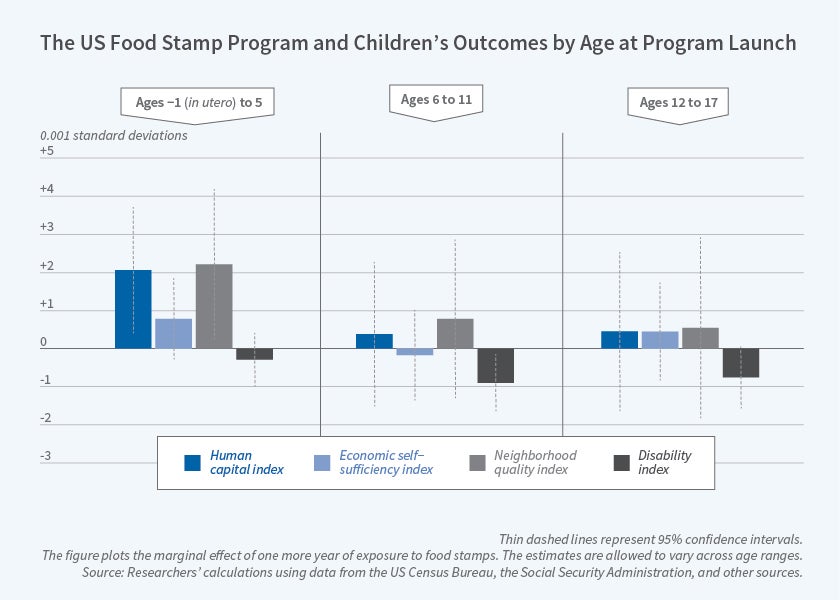Effects of Food Stamp Availability for Families of Young Children
Estimates of the long-term benefits of the SNAP program suggest that food stamps are a cost-effective use of public funds.
Providing access to food stamps for pregnant women and families with children under age five is associated with substantial subsequent gains in productivity, economic self-sufficiency, neighborhood quality, and physical health for those children when they reach adulthood. This is the central finding of Martha J. Bailey, Hilary W. Hoynes, Maya Rossin-Slater, and Reed Walker's new study, Is the Social Safety Net a Long-Term Investment? Large-Scale Evidence from the Food Stamps Program (NBER Working Paper 26942), which offers a comprehensive analysis of the long-term consequences of program access.
Food stamps, known today as the Supplemental Nutrition Assistance Program (SNAP), were launched during President Lyndon B. Johnson's War on Poverty and introduced nationwide between 1961 and 1975 to provide low-income families with food resources. Currently, SNAP is the second-largest anti-poverty program for children in the United States. Roughly one-third of Americans living in poverty are children.
This study examines the effects of food stamps access in early childhood on individuals' long-term well-being, using data on 17.5 million Americans between the ages of 25 and 54. The data include people who were children before, during, and after the introduction of food stamps — which occurred on a county-by-county basis — and who were also present in the 2000 Census or the 2001–13 American Community Surveys. The researchers linked these data to the Social Security Administration's files containing information on individuals' counties and dates of birth, enabling them to measure food stamps access. The study estimates long-term effects by focusing on whether a child had access to food stamps at different ages in the county of birth — rather than whether the child participated in the program.
The key finding is that a composite index of well-being for adults with access to food stamps throughout childhood is 0.009 standard deviations higher than the corresponding index for those without access. This index includes four components. First is an individual productivity and human capital index, which reflects years of schooling and professional occupations. This index increased by 0.010 standard deviations. Second, an economic self-sufficiency index indicates the number of years working and not in poverty, which rose by 0.004 standard deviations. The researchers note that this suggests that the food stamp program “pays for itself” over time by keeping children who have access to food stamps off of the public support payrolls as adults. Third is a neighborhood quality index, which tracks home and rent values as well as mobility to better neighborhoods. This index increased by 0.012 standard deviations. Last is a physical disability index, which tracks longevity and other key health metrics. Exposure to food stamps throughout childhood is associated with a gain in life expectancy of 0.18 years and a reduction in the likelihood of incarceration of 0.08 percentage points. The researchers did not have data to determine the precise underlying mechanisms for these improved outcomes.
The researchers also considered the long-term effects of food stamp access for families with children aged 6 to 18. The estimated benefits were nominal. The researchers suggest that supporting expecting mothers and new parents with food stamps translates directly into benefits for their children in adulthood.
— Jennifer Roche



